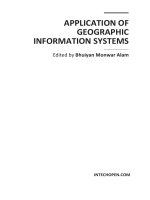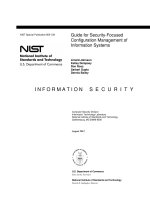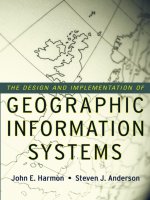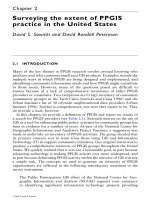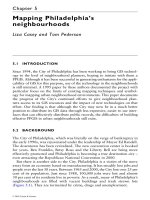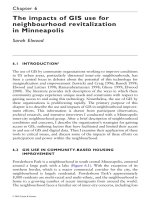APPLICATION OF GEOGRAPHIC INFORMATION SYSTEMS potx
Bạn đang xem bản rút gọn của tài liệu. Xem và tải ngay bản đầy đủ của tài liệu tại đây (48.72 MB, 384 trang )
APPLICATION OF
GEOGRAPHIC
INFORMATION SYSTEMS
Edited by Bhuiyan Monwar Alam
Application of Geographic Information Systems
Edited by Bhuiyan Monwar Alam
Contributors
Rodrigo Nobrega, Colin Brooks, Charles O’Hara, Bethany Stich, Enguerran Grandchamp, Darka
Mioc, François Anton, Christopher M. Gold, Bernard Moulin, Jung-Sup Um, Süleyman İncekara,
Marek Kachnic, Barbara Goličnik Marušić, Damjan Marušić, Xinshen Diao, Liangzhi You, Vida
Alpuerto, Renato Folledo, Nikos Krigas, Kimon Papadimitriou, Antonios D. Mazaris, Rolando
Rodríguez, Pedro Real, David Sanz, Santiago Castaño, Juan José Gómez-Alday, Tatiana S. da
Silva, Maria Luiza Rosa, Flávia Farina, Fazel Amiri, Abdul Rashid B. Mohamed Shariff, Taybeh
Tabatabaie, Ilham S. M. Elsayed, Nicolai Guth, Philipp Klingel, Alka Patel, Nigel Waters,
Shih-Miao Chin, Francisco M. Oliveira-Neto, Ho-Ling Hwang, Diane Davidson, Lee D. Han,
Bruce Peterson, J. Ponce, A.H. Torres, M.J. Escalona, M. Mejías, F.J. Domínguez-Mayo
Published by InTech
Janeza Trdine 9, 51000 Rijeka, Croatia
Copyright © 2012 InTech
All chapters are Open Access distributed under the Creative Commons Attribution 3.0 license,
which allows users to download, copy and build upon published articles even for commercial
purposes, as long as the author and publisher are properly credited, which ensures maximum
dissemination and a wider impact of our publications. After this work has been published by
InTech, authors have the right to republish it, in whole or part, in any publication of which they
are the author, and to make other personal use of the work. Any republication, referencing or
personal use of the work must explicitly identify the original source.
Notice
Statements and opinions expressed in the chapters are these of the individual contributors and
not necessarily those of the editors or publisher. No responsibility is accepted for the accuracy
of information contained in the published chapters. The publisher assumes no responsibility for
any damage or injury to persons or property arising out of the use of any materials,
instructions, methods or ideas contained in the book.
Publishing Process Manager Sandra Bakic
Typesetting InTech Prepress, Novi Sad
Cover InTech Design Team
First published October, 2012
Printed in Croatia
A free online edition of this book is available at www.intechopen.com
Additional hard copies can be obtained from
Application of Geographic Information Systems, Edited by Bhuiyan Monwar Alam
p. cm.
ISBN 978-953-51-0824-5
Contents
Preface IX
Chapter 1 Multi-Scale GIS Data-Driven Method for Early Assessment
of Wetlands Impacted by Transportation Corridors 1
Rodrigo Nobrega, Colin Brooks, Charles O’Hara and Bethany Stich
Chapter 2 Raster and Vector Integration for Fuzzy
Vector Information Representation Within GIS 21
Enguerran Grandchamp
Chapter 3 Map Updates in a Dynamic Voronoi Data Structure 37
Darka Mioc, François Anton,
Christopher M. Gold and Bernard Moulin
Chapter 4 Feng-Shui Theory and Practice Investigated
by Spatial Regression Modeling 65
Jung-Sup Um
Chapter 5 Do Geographic Information Systems (GIS)
Move High School Geography Education Forward in Turkey?
A Teacher's Perspective 83
Süleyman İncekara
Chapter 6 Probabilistic Evaluation of the Extent of the Aquifer
– Case Study 101
Marek Kachnic
Chapter 7 Behavioural Maps and GIS
in Place Evaluation and Design 113
Barbara Goličnik Marušić and Damjan Marušić
Chapter 8 Assessing Agricultural Potential in South Sudan –
A Spatial Analysis Method 139
Xinshen Diao, Liangzhi You, Vida Alpuerto and Renato Folledo
Chapter 9 GIS and ex situ Plant Conservation 153
Nikos Krigas, Kimon Papadimitriou and Antonios D. Mazaris
VI Contents
Chapter 10 Use of GIS to Estimate Productivity of Eucalyptus
Plantations: A Case in the Biobio Chile’s Region 175
Rolando Rodríguez and Pedro Real
Chapter 11 GIS Applied to the Hydrogeologic Characterization –
Examples for Mancha Oriental Aquifer (SE Spain) 197
David Sanz, Santiago Castaño and Juan José Gómez-Alday
Chapter 12 GIS Applied to Integrated Coastal Zone and Ocean
Management: Mapping, Change Detection and Spatial
Modeling for Coastal Management in Southern Brazil 219
Tatiana S. da Silva, Maria Luiza Rosa and Flávia Farina
Chapter 13 Monitoring Land Suitability for Mixed Livestock Grazing
Using Geographic Information System (GIS) 241
Fazel Amiri, Abdul Rashid B. Mohamed Shariff
and Taybeh Tabatabaie
Chapter 14 Effects of Population Density and Land Management on
the Intensity of Urban Heat Islands: A Case Study on
the City of Kuala Lumpur, Malaysia 267
Ilham S. M. Elsayed
Chapter 15 Demand Allocation in Water Distribution Network Modelling
– A GIS-Based Approach Using
Voronoi Diagrams with Constraints 283
Nicolai Guth and Philipp Klingel
Chapter 16 Using Geographic Information
Systems for Health Research 303
Alka Patel and Nigel Waters
Chapter 17 A Primer on Recent Advancement
on Freight Transportation 321
Shih-Miao Chin, Francisco M. Oliveira-Neto, Ho-Ling Hwang,
Diane Davidson, Lee D. Han and Bruce Peterson
Chapter 18 Developing Web Geographic Information System
with the NDT Methodology 349
J. Ponce, A.H. Torres, M.J. Escalona,
M. Mejías and F.J. Domínguez-Mayo
Preface
Geographic Information Systems (GIS) has emerged as one of the most important and
widely used softwares for the social scientists in last two decades. Economists,
sociologists, political scientists, public administrators, and geographers alike use GIS
for capturing, storing, analyzing, and presenting spatially referenced socio-economic
data. Election campaigns have been using GIS in a rapidly increasing manner. It has
also been substantially used by urban and regional planners, natural resources
scientists, and civil engineers. Application of GIS for land classification systems,
landslide hazard zonation mapping, land use planning, water resources engineering,
flood mapping analysis, mapping agricultural potentials, and the likes are not new
phenomena anymore. The network analyst and spatial analyst extensions of GIS are
used for advanced analysis of node-link analysis of different network systems and
spatial modeling. GIS has been further excelled by incorporating spatial
autocorrelation analysis techniques like Moran’s I index and Geary’s ratio C.
This book is geared to mastering the application of GIS in different fields of social
sciences. It specifically focuses on GIS’s application in the broad spectrum of spatial
analysis and modeling, water resources analysis, land use analysis, agricultural
potentials, infrastructure network analysis like transportation and water distribution
network, and such. While the chapter by Darka discusses map updates using dynamic
voronoi data structure system, chapters by Jung-Sup, Alka, Escalona, Krigas, Mehdi,
and Enguerran present the geospatial analysis and modeling in fields like health
research, plant conservation, transportation planning, landscape analysis, and such.
These chapters talk about raster and vector integration, virtual geographic
environment, thematic mapping, model driven engineering, and web engineering. On
the other hand, chapters by Xinshen, Fazel, Barbara, Ilham, and Rolando explore the
application of GIS in mapping and analyzing different land use characteristics and
categories. The book also introduces GIS’s application in water resources analysis –
probability mapping of ground water aquifer by Marek, coastal zone management
analysis by Luiza, and hydrologic characterization by David. Lastly, the book
elaborates the techniques that detail the use of GIS in network analysis – freight
analysis and modeling by Shih-Miao, water distribution network analysis Philipp, and
landscape and transportation planning by Rodrigo. All chapters in the book use case
studies to make the underlying theories and their applications as clearly as possible
within the scope of this book.
X Preface
A lot of people and their important roles deserve acknowledgement. First, I would like
to thank the authors for their valuable contribution in preparing the chapters. They
have presented in-depth analysis for the readers to easily understand the ways GIS
could be applied to varieties of subfields within the realm of social sciences. The
authors made my job fairly easy by providing well-written chapters. Second, I am
grateful to InTech publisher for keeping trust in my ability to edit this book. I
specifically want thank the book coordinators and production managers for their
patience while I was editing it. This book would not have been published in the
absence of the help of the publisher. Third, I sincerely thank my beloved wife and life
partner Sharmin Sultana, and two best gifts from the Almighty – my sons –
Mubashshir Ra’eed Bhuiyan and Mashrafi Ryaan Bhuiyan. Finally, I extend my
advanced thanks to the readers of this book. The hard works and sacrifices done by
the authors, a group of wonderful but professionals working in InTech publisher, and
others will only be successful if the readers find this book useful. While the credits go
to the authors and publisher, I am responsible for any unintended errors that I was
supposed to address but omitted due to human error.
Bhuiyan Monwar Alam
The University of Toledo,
Ohio, USA
Chapter 1
© 2012 Nobrega et al., licensee InTech. This is an open access chapter distributed under the terms of the
Creative Commons Attribution License ( which permits
unrestricted use, distribution, and reproduction in any medium, provided the original work is properly cited.
Multi-Scale GIS Data-Driven Method
for Early Assessment of Wetlands
Impacted by Transportation Corridors
Rodrigo Nobrega, Colin Brooks, Charles O’Hara and Bethany Stich
Additional information is available at the end of the chapter
1. Introduction
The correlation between transportation systems and adverse impacts on the natural
environment have been investigated at different scales of observation (Kuitunen et al., 1998;
Bouman et al., 1999; Corrales et al., 2000; Formann et al., 2003, Wheeler et al., 2005, Fletcher
and Hutto, 2008). There is a growing body of literature reporting and quantifying the effects
caused by transportation infrastructure on the proximate biophysical setting as shown in
(Keller & Largiardèr, 2003) as well as on the socio-economic setting as shown in (Boarnet &
Chalermpong, 2001). The environmental consequences of landscape fragmentation in different
phases of transportation project development have been investigated and tabulated by
(Corrales et al., 2000). However, the disparity of definitions for the biophysical landscape can
make it difficult to communicate clearly and even more difficulty to establish consistent
management policies. Landscape invariably comprises an area of land containing a mosaic of
patches or land elements (McGarigal & Marks, 1995; Hilty et al., 2006). The overall knowledge-
base of transportation systems and methods to consider, minimize, and mitigate adverse
impacts on natural systems and biophysical settings have gradually been absorbed and
adopted by transportation and Environmental Impact Assessment (EIA) practitioners to
design balanced engineering solutions and deliver transportation infrastructure in an
environmentally responsible manner. The body of science and knowledge supporting
practitioners has grown through in-depth reviews about transportation and ecological effects
(Spellerberg, 1998; and Formann et al., 2003) Similarly, the knowledge base concerning the
impacts of land use on travel behaviour is also being investigated and developed from the
transportation perspective (Mokhtarian & Cao, 2008; Litman, 2008).
Road development is a primary mechanism responsible for habitat, ecosystem, and overall
biophysical fragmentation, replacing or modifying pre-existing land cover such as wetlands,
Application of Geographic Information Systems
2
creating edge habitat and altering landscape structure and function (Saunders et al., 2002).
While conserving the remaining natural environment as well as restoring environmentally
impacted areas is vital for natural sustainability, transportation corridor development is
required by society and results in our modern transportation infrastructure and travel
patterns.
Previous lessons learned show that environmental issues should be considered early the
transportation planning process in order to balance economic, engineering and natural
sustainability perspectives (Amekudzi & Meyer, 2006). A highway design that meets the
transportation corridor needs, while minimizing environmental impacts, requires
cooperation and compromise among different parties. It is a pressing challenge for
researchers and practitioners to develop and validate novel methods for transportation
planning that deliver streamlined planning approaches and improved environmental
benefits beyond those possible through traditional approaches (Spellerberg, 1998; Stefanakis
& Kavouras, 2002; Mongkut & Saengkhao, 2003; Huang et al., 2003; Gregory et al., 2005).
The integration of transportation demand, current and long term development plans, and
economic and ecological impacts in time-series scenarios by using land cover and land use
analysis is a good way to provide promising results (Saunders et al. 2002; Forman &
Alexander, 1998). The use of Multi-Criteria Decision Making (MCDM) as a decision-making
framework for transportation infrastructure planning, which can accommodate, model, and
combine varying stakeholder values and help to resolve conflicting opinions, is an area that
has only been recently explored. Initial results offer significant promise to streamline the
National Environmental Policy Act (NEPA) process (Nobrega et al., 2009).
MCDM can facilitate the integration of different planning scenarios as well as the
combination of different approaches for environmental sustainability in transportation
planning. In modern transportation projects, considerations of both landscape analyses and
natural-economic sustainability are mandatory under programs such as NEPA and similar
state and local-level laws (Corrales et al., 2000). In 2003, Burnett and Blaschke demonstrated
that advances in informatics and geographic information tools have made it possible to
segment the complex environments supported by the ecological theory into factors that may
be considered in a landscape analysis approach. Current reviews about geospatial landscape
analysis in ecology reflect the relatively recent trend towards the use of remote sensing
through object-based image analysis (Blaschke et al., 2001; Burnett & Blaschke, 2003; Aplin,
2005). Geographic Object-Based Image Analysis (GEOBIA) employs polygons as bounding
areas which delimit the landscape and enable data and image analyses that transcend
traditional per-pixel approaches such as spectral-based analysis (Nobrega, 2007; Hay &
Castilla, 2008). The use of object-based segments for landscape analysis enable the
generation of a large number of parameters based not only on intrinsic values extracted
from the polygons, but also extrinsic values computed from the geometry, texture, and
context of the objects. This information can be used to form a classification decision
hierarchy and provide results that may be combined with existing GIS information to offer
significant and innovative results to benefit transportation planning and management and
streamline the Environmental Analysis processes (Nobrega, 2007).
Multi-Scale GIS Data-Driven Method for Early Assessment of Wetlands Impacted by Transportation Corridors
3
2. Background
2.1. Watersheds as natural biophysical landscape segments
Hydrological watersheds are natural subdivisions of the landscape and exercise influence
on other natural and man-made features. Wetlands are among the most sensitive of
natural features and are vital components of the habitat requiring protection from adverse
impacts that may be caused by human development and infrastructure projects. Indeed,
NEPA requires transportation planners to consider possible impacts on the hydrological
system including stream crossings, flood plains, land cover, and wetlands as part of
maintaining the ecological and biophysical balance within the local watersheds
(Amekudzi & Meyer, 2006).
This research describes the use of a collaborative, interactive, and iterative multi-scale
approach to assess and rank hydrologically segmented features and wetlands to deliver
enhanced understanding of how these biophysical systems are affected by transportation
infrastructure projects. This chapter addresses a two-level object-based landscape analysis
computed from hydrological sub-watersheds from Hydrologic Unit Code 12-level (HUC-
12), wetlands, and a subsegment of the proposed Interstate 269 (I-269, a proposed bypass
around Memphis, Tennessee, in the southern United States of America) as major objects of
interest. Firstly, parameters are extracted per watershed from percentage of wetlands,
zoning, existing and current developments, and density of perennial and intermittent
streams. Watersheds are ranked according the potential for risk on the natural environment,
as described below. The watersheds are considered as primary objects in this hierarchical
landscape analysis. After ranking these objects, the next step in the hierarchical analysis
process is identifying and ranking wetlands based on potential for adverse impact. For each
watershed, topographic analysis (computed from LiDAR elevation data) and computer-
assisted image interpretations are performed to enhance the delineation of the wetlands.
Wetlands are analyzed according their distance from planned developments, planned roads
and the I-269 corridor.
It should be recognized that there are limitations inherent to geospatial data and their
analysis within any research framework, and the practical implementation of innovative
contributions for geospatial analysis depends upon properly designing and structuring
approaches that may be implemented in a practical and feasible framework available in
readily available GIS software. In this paper, a top-down GIS framework for landscape
analysis is proposed using hydrological watersheds as reference objects for segmentation of
the landscape. This segmentation facilitates the geographical analysis of biophysical
subdivisions of the landscape based on a watershed approach to conduct contextual,
geometrical, and hierarchical analysis. The overall idea is quite similar to standard
approaches in object-oriented landscape analysis; however, the use of watersheds as a
segmentation layer enables the analysis to consider biophysical subdivision as parts of
transportation corridor planning and enables the use of output results in cumulative cost
surfaces that may be employed to refine land use and corridor plans and improve agency
coordination during the NEPA process.
Application of Geographic Information Systems
4
2.2. Landscape analysis
Landscapes are shaped by the interaction of social and ecological systems (Brunckhorst,
2005). Current and future use of land, productivity and patterns of sustainability are
continually modified by humans within the landscape in spatial scales across time in
different magnitudes (Ono et al., 2005). For environmentally-focused transportation
planning, eco-regions and hydrological watersheds are keys concepts that must be
considered in landscape analysis. Understanding landscape and watershed characteristics,
the geographic context of sensitive environmental resources, and the services provides by
natural systems, is vital to providing balanced solutions for sustainable development amidst
natural resources that face economic and social issues (Figure 1). Despite the similarity in
some points of view between creating subdivisions of eco-regions and watersheds, a
common misunderstanding of each of these landscape subdivision frameworks has resulted
in inconsistency in their use and, ultimately, to ineffective application in addressing
landscape analysis (Omernik & Bailey, 1997).
Figure 1. Complex spheres of interaction reflecting human values, identity, and activities affecting
landscape change (Brunckhorst, 2005).
2.3. Geographic object-based analysis
The traditional methods of classifying remote sensing data are based upon statistical and
cluster-based classification of single pixels in a digital image (Lillesand & Kiefer, 2004).
Recent research indicates that pixel based classification methods may be less than optimal in
producing high-accuracy land use / land cover maps since they do not consider the spatial
relationships of landscape features (Schiewe et al., 2001). For example, a significant
Multi-Scale GIS Data-Driven Method for Early Assessment of Wetlands Impacted by Transportation Corridors
5
proportion of the reflectance recorded for a single pixel is derived from the land area
immediately surrounding the pixel (Townshend et al., 2000). Analyzing at the polygon
object scale enables imagery classification to move beyond this traditional problem.
Contemporary object-based landscape analysis uses parameters derived from hierarchy,
context and geometry of the image objects rather than pixel values. Despite a successful
history with remote sensing, the accuracy of pixel-based image analysis can be
compromised when applied to high resolution images (Nobrega, 2007).
The development and practice of object-based classification has grown as have the variety
of methods and approaches of incorporating spatial context into the classification process.
Most object-based approaches compliment the axiom of landscape ecology; that it is
preferable to work with a meaningful object representing the true spatial pattern rather
than a single pixel (Blaschke et al., 2001). Furthermore, the development or use of objects
(at one or multiple scales) is always an initial primary phase of the analysis which
emphasizes capturing, extracting, or refining the size, shape, and distribution of features
of interest.
Object-based classification can be functionally decomposed into two major steps:
segmentation and classification. In the segmentation step, relatively homogeneous image
objects (polygons) are derived from both spectral and spatial information (Benz et al.,
2004). In the classification phase, image objects are labeled as to their class membership by
using established classification algorithms, knowledge-based approaches, fuzzy
classification membership degrees or a combination of classification methods (Civco et al.,
2002).
The commercial software package, Trimble eCognition Developer (formerly Definiens
Developer), has been well received as a tool for performing object-based classifications of
land cover (an example list of scientific papers using eCognition for various land cover
mapping tasks is available at />more?type=Scientific%20Paper). For automated generation of segmentation objects, the
application uses a region growing multi-scale segmentation algorithm for the delineation of
image objects. The application also enables pre-existing spatial features to be used as objects
within which segmentation may be constrained. eCognition provides two different
classification methods that may be used separately or combined: a sample-based nearest
neighbor classifier with fuzzy logic capabilities and a classifier that enables the development
of hierarchic class-membership through a set of rule-based fuzzy logic membership
functions.
This chapter presents an implementation of constrained segmentation in which naturally
occurring objects provide the initial basis for identifying relevant features on the landscape
within which classification and analysis that implement GEOBIA theory are explored. No
segmentation objects are computed, since the objects of interest (watersheds and wetlands)
already exist, and segmentation statistics are generated for these areas and used in
subsequent phases of analysis. The method combines intrinsic and extrinsic information
extracted from the objects and the analyses are organized hierarchically.
Application of Geographic Information Systems
6
2.4. Spatial MCDC-AHP in transportation planning
Driven by the need to find a balanced solution among conflicting scenarios and because of
the vast and growing availability of geospatial data, decision making theory has been
explored by the environmental assessment community, including transportation planners.
Multi-Criteria Decision Making is a systematic methodology to generate, rank, compare,
and make a selection from multiple conflicting alternatives using disparate data sources and
attributes (Gal et al., 1999; Nobrega et al., 2009). The applicability of MCDM is being
extended to many different fields including GIS, which is capable of handling massive
amounts of geospatial data. Analytical Hierarchy Process is a decision making approach
introduced by (Saaty, 1994) based on pair-wise comparisons among criteria and factors in
different hierarchical levels. AHP is presented as an effective technique for combining
heuristic inputs from stakeholders to achieve a consensus-based decision. The technique
allows competing agency expert views as well as stakeholder opinions to be considered
quantitatively in a decision making approach (MacFarlane et al., 2008). In keeping with the
spirit of NEPA, AHP does not pre-select any specific alternative; it exposes all potential
alternatives to the analysis and selection process.
AHP is robust and easily implemented in GIS for geospatial analysis. Results demonstrated
in (Sadasivuni et al., 2009) and (Nobrega et al., 2009) showed that AHP can provide
significant benefits in facilitating multi-criteria decision-making for planning. AHP is a tool
useful for planning and can lead to stakeholder buy-in on planning approaches that
consider resource allocation, benefit/cost analysis, the resolution of critical conflicts, and
design and optimization. This chapter explores a practical application of spatial MCDM-
AHP for transportation planning. The solution presents a semi-automated approach based
on an adaptation of Dr. Saaty’s theory.
3. The study area: Initial processing
The Interstate 69 is a proposed 1,600-mile long corridor that connects Canada to Mexico. The
entire corridor is divided into 32 Segments of Independent Utility (SIU) for transportation
planning and construction purposes. SIU-9 ranges from Millington, TN down to Hernando,
MS, crossing the metropolitan area of Memphis, TN and reusing some existing roads such
as I-55. However, a new I-269 bypassing the metropolitan Memphis, TN area to the east has
been approved through an Environment Impact Statement (EIS) process and is entering the
construction phase (Figure 2). The I-269 bypass is the test-bed for a series of research
projects sponsored by the National Consortium for Remote Sensing in Transportation -
Streamlined Environmental and Planning Process- (NCRST-SEPP). This work is
concentrated in Desoto County-MS, which is traversed by the designed I-269.
The NCRST-SEPP project ( applied remote sensing technology
and geospatial analysis to streamlining the EIS process for a specific on-the-ground
transportation project. NCRST-SEPP research was designed to demonstrate the innovative
application of commercial remote sensing and spatial information technologies in specific
Multi-Scale GIS Data-Driven Method for Early Assessment of Wetlands Impacted by Transportation Corridors
7
environmental and planning tasks and activities, validating the use of those technologies by
conducting rigorous comparison to traditional methods (Dumas et al., 2009).
Figure 2. The route of the I-269 bypass including alternatives considered during the EIS process. The
study extends along the I-269, in Desoto County, Mississippi, near Memphis-Tennessee.
To make the proposed top-down watershed-wetlands framework analysis useful, this work
utilized local geodata provided by Desoto County, MS, such as the transportation network,
hydrographical data, LiDAR elevation data, zoning and the county comprehensive plan. A
large collection of three-inch resolution aerial images provided support to enhance
evaluation of wetland locations. Additionally, wetlands and hydric soil information
extracted from satellite radar imagery were used to cover the lack of National Wetlands
Inventory federal wetlands data for this specific area (Brooks et al., 2009).
3.1. Overcoming the lack of NWI information in North Mississippi
In our investigation of efficient methods to provide early assessment to wetlands potentially
impacted by transportation corridors, we adopted existing findings of woody wetlands in
North Mississippi. According to (Brooks et al., 2009), the motivation in improved methods
of mapping forested (or “woody”) wetlands areas was two-fold: National Wetlands
Inventory (NWI) digital mapping information of wetlands location is unavailable for
approximately ¼ of the lower 48 U.S. States, including northwest Mississippi, based on the
U.S. Fish and Wildlife Service NWI “Wetlands Online Mapper”; and forested wetlands are
Application of Geographic Information Systems
8
very poorly mapped using traditional mapping methods including optical remote sensing
(Sader et al., 1995; Bourgeau-Chavez et al., 2001).
Figure 3. Availability of national wetland data (Modified from U.S. Fish and Wildlife Service, National
Wetland Inventory, background image source: Google Earth.
Given this data gap and problems with available traditional sources, we adopted the results
described by (Brooks et al., 2009) that used a combination of radar remote sensing data with
object-based techniques to compute potential woody wetlands and create a soil moisture
index map for the NCRST-SEPP project (Figure 4).
4. The top-down watershed-based landscape analysis
The partition of the landscape into hydrological watersheds was a logical ecologically-
focused way to explore the context interactions between the natural and the man-made
features. The methodology employed concepts of object-based geographical analysis to
evaluate the level of landscape impact of the proposed transportation corridor scenarios.
The focus on hydrological watersheds as principal objects made the main difference in
comparison with the traditional object-oriented landscape analysis. Two levels of hierarchy
were addressed in this work:
1. Watersheds were identified and ranked according certain criteria as a significant
percentage of unfavourable zoning, density of streams, wetlands and future man-made
constructions.
2. Wetlands identified and ranked for each watershed. This used topographical LiDAR
data, image interpretation and the wetlands impacted by the designed I-269 corridor.
Multi-Scale GIS Data-Driven Method for Early Assessment of Wetlands Impacted by Transportation Corridors
9
Figure 4. Potential woody wetlands product for the NCRST-SEPP I-269 study area.
4.1. Defining objects in a hierarchical landscape analysis in GIS
An I-269 area GIS was developed to improve the capabilities of geographical analysis by
providing ways to access, process, store and disseminate large amounts of information in
comparison with human tasks. The traditional GIS features (points, lines and polygons) enable
a series of spatial operations as union, overlapping, intersection, etc. Some of these operations
were used when integrating the watershed polygons and the landscape layers of information
on the first level and when assessing and refining wetlands on the second level (Figure 5).
4.2. Level I: Identification of watersheds
The first step was the identification of the HUC-12 watersheds intersected by the part of the
I-269 bypass that included alternative routes in the southeast part of the area located in
northwest Mississippi. A simple spatial intersection operation highlighted ten watersheds as
shown in Figure 6.
Selecting the watersheds intersected by the I-269 corridor options area caused a significant
reduction in the field study area and, consequently, the optimization of the data to be
processed. Thus, the next step assessed the numerical criteria that enabled ranking the
selected watersheds. At this point, the polygons of the 10 selected watersheds were
intersected with other layers of information such as 100 year floodplain, hydrograph,
existing roads and urban features, planed roads and developments and zoning in order to
extract features to quantify the system. Figure 7 illustrates the layers used in this
intersection.
Application of Geographic Information Systems
10
Figure 5. The basic workflow for the two levels of the hierarchical process.
Figure 6. The HUC-12 watersheds intersected by the part I-269 analyzed in Desoto County-MS, which
was the section with corridor options assessed as part of the EIS.
In order to make straightforward the process, the zoning map in particular was previously
reorganized into 5 classes: agriculture (green), residential (yellow), agriculture-residential
(light green), commercial (red) and industrial (orange). Similarly, the maps of existing roads
and existing buildings provided by Desoto County GIS Department were combined to
Multi-Scale GIS Data-Driven Method for Early Assessment of Wetlands Impacted by Transportation Corridors
11
produce a density map that reflects the urbanized areas. These steps were necessary since no
map of this kind was found to be available in existing GIS databases.
Figure 7. Spatial intersections between the selected wetlands and the layers of interest to assess
watershed characteristics to be used in the MCDM process.
Aiming to simplify the decision making process, quite a few different impact factors were
assigned to the layers of interest, ranging from 1 (low impact) to 9 (high impact). These
values were hypothetical, but reflected the importance of the features due to the potential
environmental impact upon existing wetlands. The percentage of covered areas was
computed per watershed for the following GIS layers: watersheds, 100 year floodplain, dense
urban, future developments, residential, agriculture, agriculture-residential, commercial and
Application of Geographic Information Systems
12
industrial. Similarly, the density of linear features (km per Km
2
) was computed per
watershed for the layers perennial streams, intermittent streams and planned roads. Table 1
presents the relative values extracted per layer from the selected watersheds. These numbers
were used to compute the ranking through the weighted average, as show in the Equation 1.
0Rank A C E F H 3*J 5*B I 7*K L 9*D G / 5
(1)
Table 1. Relative values computed per layer per watershed (percentage of area and density of linear
features)
4.3. Level II: Identification of the wetlands
Unlike the federal and small-scale geodata, local (large-scale or ground-level) geodata
normally demand substantial time to be computed due to the high resolution and accuracy
involved. Aerial images, high resolution satellite images and LiDAR are the most data
intensive information in GIS in terms of storage and interpretation requirements.
Minimizing computational efforts by analyzing the landscape, subdividing the geography
into semi-homogeneous units, selecting units for further detailed analysis, and prioritizing
areas of interest is key to reducing the geographic extent of the study, reducing the
computational cost of the study, and supporting the top-down approach in geospatial
analysis in which the analysis funnels options down into a reduced set of possible
alternatives.
Given the completion of Level I processing described, a series of GIS analyses using
information extracted from the topographic surface, such as topographic depressions and
flat areas, as well as image analysis such as land cover, provided enhanced inputs to refine
wetlands feature geometry as well as classifications based on the radar-based wetland
mapping results.
The following processes were developed for the watershed #0, which is second in the
ranking as shown in the results section (Figure 8); it serves as a representative example for
more detailed examination in this chapter. The reason is that the top-ranked watershed
covers a small area and is mostly composed by developed areas and does not present a large
Multi-Scale GIS Data-Driven Method for Early Assessment of Wetlands Impacted by Transportation Corridors
13
variety of landscape features (including wetlands) to illustrate the exercise proposed in this
work.
The geospatial analysis was performed using map algebra, so features in vector formats
were converted to raster format. Due to landscape analysis considerations and the potential
implications of I-269 and planned roads, the layers of information selected in this level
(Level II) emphasize the hydrographic and physical aspects, which are basis for engineering
construction perspectives.
Figure 8. The layers employed to refine and rank the wetlands per watershed. For display purposes,
the impact factor ranges from green (low) to red (high).
Table 2 presents the layers used to refine the wetlands features, their respective criteria for
classification and the weight to be used on MCDM. Distance criteria and weights are
hypothetical; however, they reflect the goal of the paper on assessing potential impacted
wetlands.
